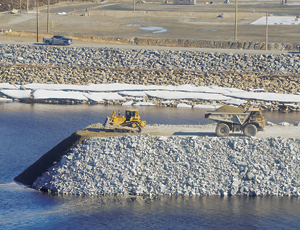Construction of a cofferdam nearly 800 m long at the Eastmain-1-A intake was one of his biggest challenges, says Denis Groleau, Eastmain site manager. It had to be built out from the banks of the reservoir by dumping material off the end of the advancing dam into water up to 21 m deep.

The key issue was to determine the ideal distance between the advancing face of the crushed-aggregate core and the riprap of the lateral embankments. The solution, he found, was not fancy modeling software—no such program was available. Rather, it was an old-school, 3D, 1:60 scale model in a laboratory. LaSalle Consulting Group, LaSalle, Quebec, did the modeling.
A Model Success
The tests showed that the placement of aggregate could not be allowed to advance more than 1 m ahead of the embankment’s riprap shoulders. If it did, the core material would slump too much at the base and leave inadequate space for placement of the riprap. The scale model did the trick. “The result that we got was quite like the result we got from the model,” Groleau says.
The crest of the cofferdam was slightly more than 18 m wide to allow the dump trucks room to advance, turn and dump, says Groleau. Once the dam was completed, it required a sheetpile cutoff wall to make it watertight. A vibratory hammer drove more than 700 interlocking steel sheetpiles imported from Luxembourg 1 m wide, nearly 2 cm thick and up to 25 m long to bedrock to seal the dike. Finally, 1 million cu m of water was pumped out, and excavation of the intake proceeded in the dry.
Next Up
Some seepage continues and pumps run continuously to keep the site dry, but it is well controlled, Groleau says. Demolition will be the next big challenge. He has not yet decided whether to use a dragline or barge-mounted equipment to breach the cofferdam. But only a portion of the dam must be removed for the intake to receive adequate flow.
Demolition will begin by undermining the inside, then removing the top 2 m, pumping water to fill the forebay and equalize the pressure, then removing the sheetpiles and digging out with a clamshell. Groleau estimates the dam removal will take four to five months. The remnant of the structure will be relined with large rocks to withstand wave action.













Post a comment to this article
Report Abusive Comment